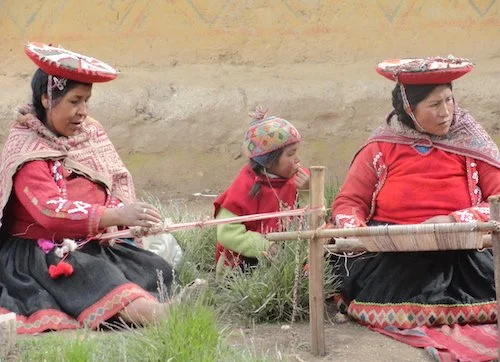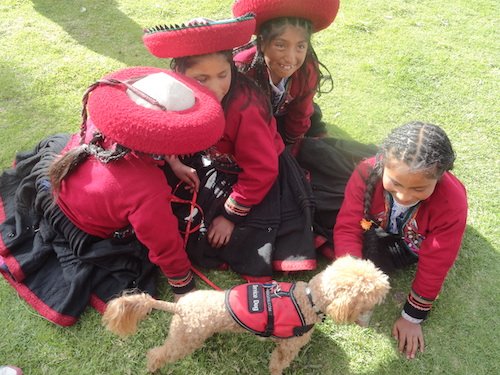Passing It On
Perhaps one of the most significant things that we can do with our skills, knowledge, materials, and tools, is to pass them on to the younger generations. So many textile techniques are in danger of being lost as we move forward in this world, and it can take only one generation of disuse for knowledge to become lost.
I have had the good fortune to attend the three Tinkuy conferences in Peru, in 2010, 2013, and 2017 (see previous Off to Peru blog posts). One of my favorite events at the first two of these conferences was a ceremony in which an elder from each of the ten communities of the Center for Traditional Textiles of Peru passed on a bundle of materials and tools to a young weaver from the community.
In these traditional communities of Quechua weavers children grow up wearing exquisite handspun, hand dyed and handwoven clothing. They are watching their mothers, grandmothers, and others in the community in the process of spinning, dyeing and weaving. They absorb, almost by osmosis, an understanding of how textiles come into being.
Most of us these days don’t grow up surrounded by handmade textiles in quite the same way. If we are lucky we had a mother or grandmother who knitted, sewed, or possibly even wove, and perhaps even passed these skills on to us. For many of us the most we knew of weaving while growing up was making potholders on little frame looms. While we are fortunate to live at a time when we can go to a store and buy clothing and household linens already made, we have also lost some of our connection to how textiles are made.
I did grow up with a mother who knitted and sewed and I did start sewing my own clothes at around age twelve. And while I did weave my share of potholders on that little frame, I still didn’t have any real sense of how textiles came about or what weaving was. I feel so fortunate to have fallen into a weaving class in college that opened up a new world for me and changed the path of my life.
I had very little money or space at that time to acquire the tools or the materials that I needed to pursue this passion, and so it was a very gradual process of adding what I needed bit by bit. Most of my weaving was done on looms at community centers and had to be done at a time when they were open and available. Every now and then an older weaver would give me the use of a loom that they weren’t using or I would find a tool that I needed in an estate sale. I finally was able to buy my first secondhand floor loom about five years into my weaving life, which enabled me to weave at home any time that I wanted.
In the early 90’s I ordered a 12” wide, 8-shaft Mountain table loom so that I would have something portable to take to workshops to weave on, or as I started teaching, to be able to demonstrate on. Along the way a woodworker friend made a stand with an attached shelf to make this loom functional for me at home, and this has been a great little loom for me all these years.
I don’t have any children, but I do have one niece named Ella, who grew up in Denver, about a six-hour drive away from me. My sister periodically came for visits along with her children, and Ella and I had a pretty close relationship as she was growing up. When she was about eight years old she began taking an interest in what I was doing and asked if she could weave too. I set up my table loom with a small warp in plain weave and she took to it like a duck to water.
Around that time one of their visits fell right around Ella’s birthday and I got her a little frame tapestry loom and gathered some appropriate yarn for her to use. At that time tapestry weaver James Koehler was living nearby and I invited him over for a brunch. James gave Ella a beginner lesson on how to weave a tapestry. Perhaps someday Ella will appreciate how fortunate she was to have had a personal lesson from James, an experience that I’m sure many weavers wish they could have had.
On one visit when Ella was around twelve years old I had just returned from teaching a workshop and had a 2-block doubleweave warp already set up that I didn’t want to cut off, but thought would probably be too advanced for her. Then I figured if I just wrote out the steps of which levers to use and which shuttles to weave with she could probably follow the steps to make a little Windows sample. I showed her what to do and then went off to do something else. When I came back an hour or so later she had not only woven that sample, but had woven another one in which she had reversed the two layers, and therefore the colors. I was completely amazed and asked her how she did that. She said she just looked at what was going up and down and figured out how to do the opposite. I figured that I had a natural born weaving prodigy on my hands.
Well, then she bacame a teenager and lost her interest in weaving, and even in coming down for visits. I figured that at least she had had an introduction to weaving and would have more awareness of textiles than if she hadn’t had these experiences.
A couple years ago when I decided to start teaching on Zoom during covid I wanted to film my loom demonstrations, both on the table and the floor loom. I decided that I needed a larger table loom that would allow me to weave slightly wider warps and that would make my demonstrations easier to see. I bought a Louet Jane 8-shaft table loom that can weave about 21” wide, and I love it just as much as I did my Mountain loom. The Mountain loom was relegated to the garage, and eventually I decided that I should sell it and open up that space. I put an ad in my weaving guild newsletter, but didn’t get any takers.
About a year ago my sister said she wished I hadn’t sold that loom because Ella, who was now 27 years old, was expressing an interest in taking up weaving again. I was thrilled to know that the seeds of weaving had taken root in Ella after all, and I was thrilled that I still had that loom to pass on to her. My sister hauled the loom back up to Colorado on one of her visits and it is now living in Ella’s first house waiting to be put to use.
After about 45 years of weaving I now have more yarn and weaving tools in my stash than I will use in this lifetime. I try to make a regular practice of going through everything and thinning out things that I realize I will never use, no matter how wonderful they may be. I have often filled the back of my car with yarn, books, and other supplies and taken them up to a nearby nonprofit weaving center, and I’m now also looking at everything with an eye to what Ella might be able to use.
I don’t know whether weaving will just be a passing fancy in Ella’s life or if it will become just as important to her as it has been to me. Either way, I’m happy to know that she has an understanding and appreciation for textiles and that it is a shared bond between us. Every time we teach someone to weave, and especially when we support a younger person in learning about textiles we are helping to ensure that our field will continue to live and grow.





